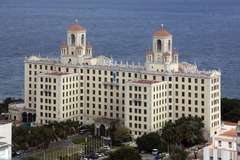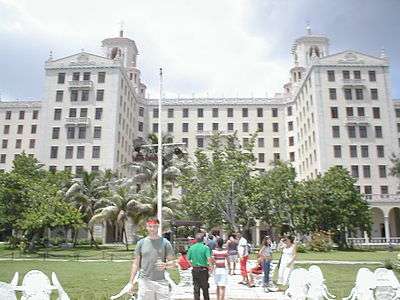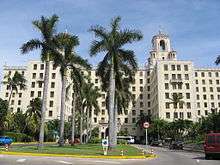Hotel Nacional de Cuba
| Hotel Nacional de Cuba | |
|---|---|
 Hotel Nacional de Cuba | |
| General information | |
| Location |
Calle 21 y O |
| Coordinates | Coordinates: 23°8′35″N 82°22′50″W / 23.14306°N 82.38056°W |
| Opening | December 30, 1930 |
| Technical details | |
| Floor count | 8 |
| Design and construction | |
| Architect | McKim, Mead and White |
| Other information | |
| Number of rooms | 457 |
| Number of suites | 16 |
| Website | |
| http://www.hotelnacionaldecuba.com | |
The Hotel Nacional de Cuba is a historic hotel located on the Malecón in the middle of Vedado, Havana, Cuba. It stands on Taganana Hill a few metres from the sea, and offers a view of Havana Harbor, the seawall and the city.
History
The hotel was developed by the US firm of Purdy and Henderson,[1] financed by the National City Bank of New York and designed by the New York architectural firm of McKim, Mead and White in a mix of styles including Sevillian, Roman, Moorish and Art Deco. The hotel was constructed in just fourteen months on the site of the Santa Clara Battery, which dates back to 1797. Part of the battery has been preserved in the hotel's gardens, including two large coastal guns dating from the late 19th Century. The hotel opened as The National Hotel of Cuba[2] on December 30, 1930, operated by the American managers of the Plaza Hotel, Savoy-Plaza Hotel and Copley Plaza Hotel,[3] at a time Cuba was a prime travel destination for Americans.
In 1933, after Fulgencio Batista's 4 September 1933 coup against the transitional government, it was the residence of Sumner Welles, a special envoy sent by U. S. President Franklin D. Roosevelt to mediate the crisis, and was the site of a bloody siege that pitted the officers of the Cuban army, who had been instrumental in the overthrow of Gerardo Machado (August 12. 1933), against the non-commissioned officers and other ranks of the Cuban army, who supported Batista. Their eventual assault on the hotel, on October 2, 1933, caused extensive damage to the building, including shell and bullet holes, and would become known as the Battle of the Hotel Nacional of Cuba.
Chicago developer Arnold Kirkeby acquired the hotel in the early 1940s and operated it for over a decade as part of his Kirkeby Hotels chain. In December 1946 the hotel hosted the Havana Conference, an infamous mob summit run by Lucky Luciano and Meyer Lansky and attended by Santo Trafficante, Jr., Frank Costello, Albert Anastasia, Vito Genovese and many others. Francis Ford Coppola memorably dramatised the conference in his film The Godfather Part II.
In the mid-1950s, Kirkeby Hotels sold the Nacional to New York developer William Zeckendorf.[4] By 1955, Lansky had managed to persuade Batista to give him a piece of the Nacional. That same year Pan Am's Intercontinental Hotels Corporation bought the hotel from Zeckendorf. Alphons Landa, prominent Washington attorney represented Pan Am and arranged for other clients and friends to acquire pieces of the hotel ownership at the same time. Dave Beck, President of the Teamsters and Roy Fruehauf of the Fruehauf Trailer Corporation were silent partners for at least 2 years. Fruehauf would sell his interest in the hotel in May 1957; other investors would lose everything when Castro came to power.[5] Lansky planned to take a wing of the 10-storey hotel and create luxury suites for high-stakes gamblers. Batista endorsed Lansky's idea even though there were objections from American expatriates such as Ernest Hemingway. Under Lansky's impetus, a wing of the grand entrance hall was refurbished to include a bar, a restaurant, a showroom and a luxurious casino. It was operated by Lansky and his brother Jake, with Wilbur Clark as the front man.[6]
In 1956, singer Nat King Cole was contracted to perform in Cuba and wanted to stay at the Hotel Nacional de Cuba but was not allowed to because he was black. The hotel had earlier turned away Joe Louis, Marian Anderson, Jackie Robinson and Josephine Baker.[7] Cole honored his contract, and the concert at the Tropicana was a huge success. The following year, he returned to Cuba for another concert, singing many songs in Spanish. There is now a tribute to him in the form of a bust and a jukebox in the Hotel Nacional.
The new wing of the elegant hotel, consisting of Wilbur Clark's famous Casino Internacional, the adjoining Starlight Terrace Bar, and the Casino Parisién night club (home of the Famous Dancing Waters), opened for business in 1956 with a performance by Eartha Kitt,[8] who became the hotel's first black guest.[9] The casino and clubs were an immediate success. According to an unpublished article sent to Cuban Information Archives around 1956-57, "The bar was tended by local bartenders, and the casino managed by gentlemen from Las Vegas."[10] By the spring of 1957 the casino, sublet by the hotel for a substantial rent to Lansky, was bringing in as much cash as the biggest casinos in Las Vegas. In late 1958 the casino was sold to Michael McLaney and Carroll Rosenbloom.
Following the Cuban Revolution in January 1959, Havana's casinos were briefly shut down, but were quickly reopened after protests by casino workers left out of work. Fidel Castro nationalized the hotel on March 20, 1960 and finally closed the casino in October 1960, almost two years after his overthrow of Batista.
Jean-Paul Sartre stayed at the hotel just after the Revolution in 1960, with his wife, the philosopher, Simone de Beauvoir.[11] The couple interviewed Che Guevara and Sartre wrote 'Sartre visits Cuba', which was published in Hanava in 1961, narrating his experiences. The hotel has since named the room he stayed in after him.
There is a museum in the hotel's gardens dedicated to its role in the 1962 Cuban Missile Crisis, when anti-aircraft guns were set up on the site of the Santa Clara Battery and an extensive series of tunnels were built under the property, which are now open to the public on guided tours.[12]
After years of neglect due to the disappearance of tourism following the revolution, the hotel was mainly used to accommodate visiting diplomats and foreign government officials. The collapse of the USSR in 1991 forced the Cuban communist party, anxious for foreign exchange reserves, to reopen Cuba to tourists.
In its 80+ years of existence, the Hotel Nacional has had many important guests, including artists, actors, athletes and writers such as Winston Churchill, the Duke and Duchess of Windsor, Jimmy Carter, Frank Sinatra, Ava Gardner, Rita Hayworth, Mickey Mantle, Johnny Weissmuller, Buster Keaton, Jorge Negrete, Agustín Lara, Rocky Marciano, Tyrone Power, Alberto Simões, Rómulo Gallegos, Errol Flynn, John Wayne, Marlene Dietrich, Gary Cooper, Marlon Brando, Ernest Hemingway, Jean-Paul Sartre, Yuri Gagarin, scientist Alexander Fleming, Minnesota (United States) Governor Jesse Ventura,[13] and innumerable Ibero-American Heads of State and European monarchs.
In 2011, Cuban-American Pop Icon Gloria Estefan released her second single "Hotel Nacional" from her album Miss Little Havana, the song it's mainly inspired on the Cuban Golden-Era of Entertainment and the international appeal of the building through the world.
Gallery
- Snapshots from Hotel Nacional de Cuba
 Hotel Nacional de Cuba, Havana.
Hotel Nacional de Cuba, Havana.
October 2002- Main entrance to the Hotel Nacional de Cuba. Poster reads "Welcome to FIT Cuba 2007 (International Tourism Fair)."
 Hotel Nacional and The Cascade fountain from Malecon Avenue.
Hotel Nacional and The Cascade fountain from Malecon Avenue. Hotel Nacional
Hotel Nacional
January 2008 Hotel Nacional
Hotel Nacional
January 2006 Sunset over Hotel Nacional, 2014
Sunset over Hotel Nacional, 2014 Fountain in the hotel's garden, October 2011
Fountain in the hotel's garden, October 2011 Musicians at the Hotel Nacional, Havana.
Musicians at the Hotel Nacional, Havana.
October 2002- Lobby of Hotel Nacional
 Elevators in the lobby of the Hotel Nacional de Cuba, October 2011
Elevators in the lobby of the Hotel Nacional de Cuba, October 2011- Old post-box in the hotel Nacional lobby
 Russian VAZ "Jiguli" taxi in front of the Hotel Nacional de Cuba, October 2011
Russian VAZ "Jiguli" taxi in front of the Hotel Nacional de Cuba, October 2011 Hotel Nacional de Cuba building
Hotel Nacional de Cuba building- Hall with pictures of historical persons who lived in hotel
References
- ↑ Hotel Nacional de Cuba lahabana.com
- ↑ Advertisement in Princeton Alumni Weekly, Volume 32 February 26, 1932 p471 via books.google.com
- ↑ Advertisement in Princeton Alumni Weekly, Volume 32 February 26, 1932 p471 via books.google.com
- ↑ Fulgencio Batista's Economic Policies, 1952 - 1958 by Michael P. McGuigan August 2012
- ↑ http://www.singingwheels.com/havana-cuba-the-southern-branch.html
- ↑ Mobsters Move in on Troubled Havana and Split Rich Gambling Profits with Batista Life magazine March 10, 1958 pp32-37
- ↑ Eartha Kitt First Black Guest of Cuba's Hotel Nacional Jet Magazine March 22, 1956 via flickr.com
- ↑ Meyer Lansky: The Mafia Mastermind in Havana cubaheritage.org
- ↑ Eartha Kitt First Black Guest of Cuba's Hotel Nacional Jet Magazine March 22, 1956 via flickr.com
- ↑ Havana Night Life by Jay Mallin, Sr.
- ↑ Sartre in Cuba–Cuba in Sartre by William Rowlandson
- ↑ https://www.huffingtonpost.com/2010/12/30/hotel-nacional-cuba_n_802769.html
- ↑ http://www.hotelnacional-decuba.com/personalidades/jesse-ventura
External links
| Wikimedia Commons has media related to Hotel Nacional de Cuba. |